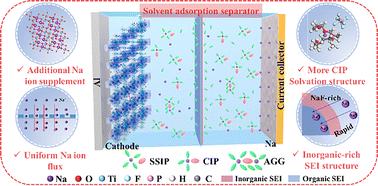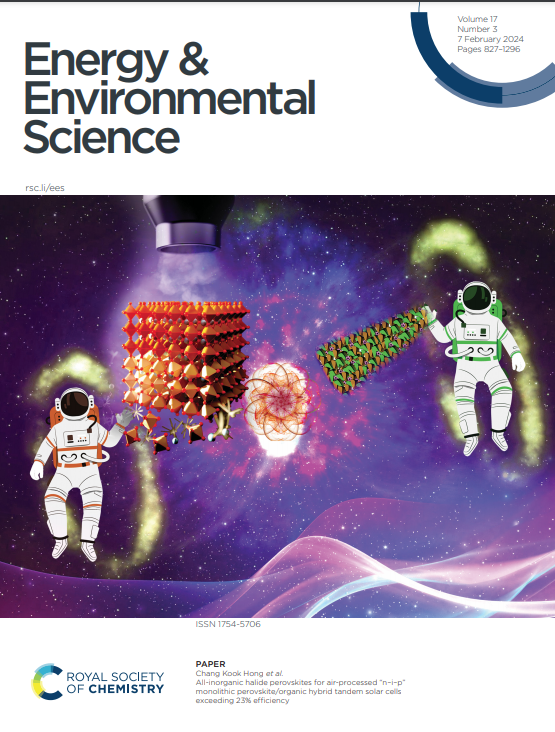利用溶剂吸附分离器提高无阳极金属钠电池的低温耐久性和钠离子输运
IF 30.8
1区 材料科学
Q1 CHEMISTRY, MULTIDISCIPLINARY
引用次数: 0
摘要
低温高能量密度电池在储能系统中已被积极研究了几十年。无阳极金属钠电池(AFSMBs)已经成为一种很有前途的电池配置,通过消除传统的阳极材料来提高能量密度。然而,它们在低温环境中的实际应用仍然受到两个关键挑战的限制:循环过程中镀钠/剥离过程的动力学不足和固体电解质界面的不稳定性。本文提出了一种多功能分离器的设计策略,即采用添加Na的溶剂吸附分离器(SAS-N)来提高afsmb的低温性能。SAS-N作为补充钠储层,通过改善电解质的润湿性来减轻不可逆的钠耗尽和增强界面相容性。此外,SAS-N调节了更多的接触离子对溶剂化结构,促进了富无机固体电解质界面相(SEI)的形成。这种重建的界面同时稳定了电极/电解质界面的电化学反应,并加速了钠离子在低温下的传输动力学。基于sas的afsmb具有超长的可循环性,在25°C条件下,在600次循环中保持95.06%的容量,而在- 20°C条件下,在1000次循环中保持92.53%的容量。本工作为提高afsmb低温性能的分离器工程提供了一条新的途径。本文章由计算机程序翻译,如有差异,请以英文原文为准。

Enhancing low-temperature durability and sodium-ion transport of anode-free sodium metal batteries through utilization of a solvent adsorption separator
A battery with high-energy density at low-temperature has been actively pursued in energy storage systems for decades. Anode-free sodium metal batteries (AFSMBs) have emerged as a promising battery configuration for enhanced energy densities by eliminating conventional anode materials. Nevertheless, their practical implementation in low-temperature environments remains constrained by two critical challenges: insufficient dynamics for sodium plating/stripping processes during cycling and instability of the solid electrolyte interphase. Herein, a strategy of multifunctional separator design by employing a solvent adsorption separator with Na supplementation (SAS-N) is proposed to enhance the low-temperature performance of AFSMBs. SAS-N acts as a supplemental sodium reservoir to mitigate irreversible sodium depletion and enhance interfacial compatibility through improved electrolyte wettability. Furthermore, SAS-N modulates more contact ion pair solvation structures, facilitating the formation of an inorganic-rich solid electrolyte interphase (SEI). This reconstructed interface simultaneously stabilizes electrochemical reactions at the electrode/electrolyte interface and accelerates sodium-ion transport kinetics at low temperature. SAS-based AFSMBs demonstrate ultralong-term cyclability, retaining 95.06% capacity over 600 cycles at 25 °C while sustaining 92.53% capacity retention through 1000 cycles under harsh −20 °C operation. This work provides a new approach of separator engineering to improve the low-temperature performance of AFSMBs.
求助全文
通过发布文献求助,成功后即可免费获取论文全文。
去求助
来源期刊

Energy & Environmental Science
化学-工程:化工
CiteScore
50.50
自引率
2.20%
发文量
349
审稿时长
2.2 months
期刊介绍:
Energy & Environmental Science, a peer-reviewed scientific journal, publishes original research and review articles covering interdisciplinary topics in the (bio)chemical and (bio)physical sciences, as well as chemical engineering disciplines. Published monthly by the Royal Society of Chemistry (RSC), a not-for-profit publisher, Energy & Environmental Science is recognized as a leading journal. It boasts an impressive impact factor of 8.500 as of 2009, ranking 8th among 140 journals in the category "Chemistry, Multidisciplinary," second among 71 journals in "Energy & Fuels," second among 128 journals in "Engineering, Chemical," and first among 181 scientific journals in "Environmental Sciences."
Energy & Environmental Science publishes various types of articles, including Research Papers (original scientific work), Review Articles, Perspectives, and Minireviews (feature review-type articles of broad interest), Communications (original scientific work of an urgent nature), Opinions (personal, often speculative viewpoints or hypotheses on current topics), and Analysis Articles (in-depth examination of energy-related issues).
 求助内容:
求助内容: 应助结果提醒方式:
应助结果提醒方式:


